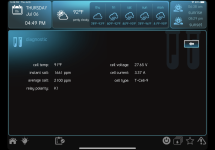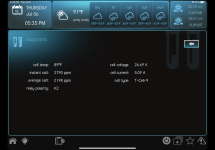- Add bookmark
- #1
Just wanted some opinions on what appears to be a failing T-9 cell since this is the first salt cell I will have to replace.
Built pool in March of 2016 - T-9 is the original salt cell. No issues since 2016. Recently got a “Chlor Too Low Salt” warning. Salt read low on the OmniLogic board and app. Added salt, still had warning. Took water to the place I never go for readings (Pinch A Penny) who said salt reading was at 3400. Now I have a Taylor salt test kit arriving today BTW so I can test salt too.
Been a few days but have been monitoring whether I was generating chlorine and seemed to be doing so. But, in the last two days my chlorine has really dropped. Salt cell sensor says 2100 but I am still at 3350 salt when tested. Started reading about how to tell from the diagnostics when salt is and is not being generated because I’d see a cell current of zero sometimes (but from what I understand that is expected if you have the chlorinated set, for examole, like I do at 40%).
So, I upped the chlorination to 100% (which should keep the cell from reading zero?) and here are the numbers and the cell current is no longer reading zero which I believe means it is generating chlorine but it sounds like that current would normally be higher than in the 3’s.

Given it is a 7 year old cell it’s easy to assume it has lived it’s life. Just a little thrown off as to why it is not just reading zero all the time unless it is just on life support at this point but wanted the thoughts of those who have gone threw T-9’s since this is the first time I may/will have to replace it.
Last edited:
2100/3350 is .626. The cell is used up.
You might get a week or so out of it by changing the cell type to T5 or even T3. See what the salt readout says when you change that.
I appreciate you response James. How to you change the cell type to T5 or T3 as I didn’t see that as an option on the board (but buying a week would be helpful in order to get it replaced)?
Also, I just now switched the polarity to K2 and the cell amps went up to 5.09 from 3.37 and instant and average salt went way up. Is that normal? Oh, in case anyone else sees this later I also thoroughly cleaned the (old) cell as well.

- Add bookmark
- #4
Likely one set of plates is less worn out than the other.
From the Wiki I linked to above.
With the correct cell in place, move the switch to auto and momentarily push the diagnostic button to display the cell type "T-X". Then move the switch to Superchlorinate and back to auto 3x or until T-15 or whatever the correct cell type is shown on the display.
Likely one set of plates is less worn out than the other.
From the Wiki I linked to above.
With the correct cell in place, move the switch to auto and momentarily push the diagnostic button to display the cell type "T-X". Then move the switch to Superchlorinate and back to auto 3x or until T-15 or whatever the correct cell type is shown on the display.
I don’t believe those instructions apply to my Omnilogic board. I don’t have those switches or diagnostic button.
- Add bookmark
- #11
Checking them out now. Is install as easy as plug and play? Still reading so I am sure that question will be answered soon.
Yes. Just power down everything. Use Pool Lube on the oring in the unions. Snug up hand tight. If they leak, snug a bit more. Do not go crazy with wrenches and such. Put the hump down so it works well at lower flow rates.
Maybe get a T-15 cell instead of a T-9.
Maybe get a T-15 cell instead of a T-9.
With my pool being 14,000 gallons is the benefit of the T-15 just longer life (which is a plus)?
Yes. Just power down everything. Use Pool Lube on the oring in the unions. Snug up hand tight. If they leak, snug a bit more. Do not go crazy with wrenches and such. Put the hump down so it works well at lower flow rates.
Perfect, not much different than taking it off to clean. I assumed when my neighbor said he pays his pool guy $1,200 to replace it there was more to it.
- Add bookmark
- #16
My pool is 6000 gallons and I have an IC40. Equivalent to the T15.
Longer lasting. Less run time needed. You have a VS pump so that is good. Though with an Ecostar, you should start saving for replacement. Those are prone to failure.
- Add bookmark
- #17
My pool is 6000 gallons and I have an IC40. Equivalent to the T15.
Longer lasting. Less run time needed. You have a VS pump so that is good. Though with an Ecostar, you should start saving for replacement. Those are prone to failure.
Funny you should say that about my Ecostar. Definitely hearing a whining noise which if I understand correctly is a bearings issue from a seal leak. My Tri Star pump for the water features runs so quiet still Compared to my main pump Ecostar. Here is a video I just took after seeing you mention the Ecostar -
Thoughts?
Why so much air in it? You have a suction side air leak, though I doubt that is causing the noise. What rpm is it run at? Should be able to go down to 1500 rpm or so.
Be ready to replace. The Tristar will fit right in. You could swap the one you have over if you have to wait for install. Install would be plug and play.
Why so much air in it? You have a suction side air leak, though I doubt that is causing the noise. What rpm is it run at? Should be able to go down to 1500 rpm or so.
Be ready to replace. The Tristar will fit right in. You could swap the one you have over if you have to wait for install. Install would be plug and play.
it was running at 50% which is 1725 when you heard that noise. Honestly, I think there has always been air in it at 50% (or for as long as I can remember) - didn’t sound like in the beginning for sure, lol. When at 100% definitely no air. 100% is schedule only for 15 minutes or so per day to get better skimming. Otherwise, I have always run it at 50%. I guess I cold have gone lower?
But yeah, not sure why there is air in there at 50% and assume that was normal.
Last edited:
- Add bookmark
- #20
But yeah, not sure why there is air in there at 50% and assume that was normal.
That much air is not normal as far as I can tell.
@1poolman1 has experience with that pump.











